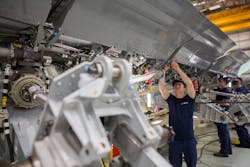Say Goodbye to LOTO: Bringing Productivity Back to Safety
Nov. 14, 2015
4 min read
If deployed correctly, an OSHA exception for Alternative Protective Measures can free your machines from the lockout/tagout productivity killer.
"Safety doesn't have to come at the expense of productivity."
If one were to boil down the Safety Technology track at EHS Today's Safety Leadership Conference into one sentence, that would be it.
It was a sentiment that was, of course, welcomed rather warmly by the crowds of EHS professionals in attendance, all of whom have likely been arguing the same point in their plants for years.
But, when Jimi Michalscheck – business development manager at Rockwell Automation – opened with that line in his session on Advanced Lockout/Tagout of all things, he left even that crowd scratching their heads. And for good reason.
In most safety systems (and regulations), there tends to be some wiggle room – space enough for clever engineers to work with the EHS team to maximize safety without interrupting the work process.
"However," Michalscheck noted, "following OSHA's lockout/tagout definition, there are certain parameters that you absolutely have to follow. There's no wiggle room."
This is what LOTO is for, he explained. No matter what you do, no matter why bypasses operators try to sneak in, the machines are off and everyone is safe.
This, while certainly providing much needed safety for the operators, can add up to some costly downtime.
Michalscheck pointed to a case packer to highlight the point.
These machines, he said, are "notorious for jamming, notorious for interlocks, and notorious for accidents and citations because of the frequency people are in them."
He estimated that a full LOTO on one of these can take up to 15 minutes to complete and that the machine can jam five times in an hour of operation. That can add up to $23,000 in lost productivity per hour, per machine, he said.
"But what if I told you," he added, "that we could design a different system that only takes 30 seconds?"
He was referring to an exception tacked on to OSHA's LOTO requirements (1910.147(a)):
"Exception to paragraph (a)(2)(ii): Minor tool changes and adjustments, and other minor servicing activities, which take place during normal production operations, are not covered by this standard if they are routine, repetitive, and integral to the use of the equipment for production, provided that the work is performed using alternative measures which provide effective protection."
This means, Michalscheck concluded, that if engineers and EHS teams can work together to create standard safety systems and equipment on their machines to handle these kinds of jams and minor service operations that provide the same measure of safety as full lockouts, then they can go without LOTO.
If deployed appropriately, Alternative Protective Measures (APMs) can provide operators the same safety and security as LOTO, but without the costly downtime.
"You don't have to shackle your productivity for safety," he said. "As long as you can design something that is as effective as lockout/tagout, you can do it. In fact, engineering safe alternatives is key to establishing advanced lockout/tagout."
The trick to this, he said, is to think of your equipment not as single, solid parts, but as a collection of individual serviceable components.
If, for example, a machine mostly jams in one particular area or one particular function, there is not necessarily a need to power down and lock out the entire machine to free it.
Rather, crews can design an alternative safety system that effectively protects workers in an isolated area of the machine, which allows them – protected by guards and triggered e-stops, for example – to quickly free the blockage, correct the errors, and restart the machine with minimal downtime.
These alternative measures, he said, can be powerful productivity tools on the plant floor, but they still require quite a bit of diligence and collaboration to design.
"If you want to do anything other than lockout, I recommend that you treat it just like lockout," he advised. "Just because OSHA doesn't require you to document, doesn't mean you don't have to do it."
The means making designing the procedures, documenting them, auditing them, training to them, and incorporating them into your policy and holding yourself to the same bar of safety that OSHA regulations demand.
Developed with care, these systems can provide some much needed wiggle room for the regulations, he said. "But what isn't allowed is an increased risk to employees by using alternative protective measure procedures. In other words, any APM developed must provide the same or greater level of protection as LOTO."
"APMs aren't just an advantage to ROI and competitive edge," he added. "These are really, really big penalties at stake." And, it's worth noting, people's lives and limbs as well.
If one were to boil down the Safety Technology track at EHS Today's Safety Leadership Conference into one sentence, that would be it.
It was a sentiment that was, of course, welcomed rather warmly by the crowds of EHS professionals in attendance, all of whom have likely been arguing the same point in their plants for years.
But, when Jimi Michalscheck – business development manager at Rockwell Automation – opened with that line in his session on Advanced Lockout/Tagout of all things, he left even that crowd scratching their heads. And for good reason.
In most safety systems (and regulations), there tends to be some wiggle room – space enough for clever engineers to work with the EHS team to maximize safety without interrupting the work process.
"However," Michalscheck noted, "following OSHA's lockout/tagout definition, there are certain parameters that you absolutely have to follow. There's no wiggle room."
This is what LOTO is for, he explained. No matter what you do, no matter why bypasses operators try to sneak in, the machines are off and everyone is safe.
This, while certainly providing much needed safety for the operators, can add up to some costly downtime.
Michalscheck pointed to a case packer to highlight the point.
These machines, he said, are "notorious for jamming, notorious for interlocks, and notorious for accidents and citations because of the frequency people are in them."
He estimated that a full LOTO on one of these can take up to 15 minutes to complete and that the machine can jam five times in an hour of operation. That can add up to $23,000 in lost productivity per hour, per machine, he said.
"But what if I told you," he added, "that we could design a different system that only takes 30 seconds?"
He was referring to an exception tacked on to OSHA's LOTO requirements (1910.147(a)):
"Exception to paragraph (a)(2)(ii): Minor tool changes and adjustments, and other minor servicing activities, which take place during normal production operations, are not covered by this standard if they are routine, repetitive, and integral to the use of the equipment for production, provided that the work is performed using alternative measures which provide effective protection."
This means, Michalscheck concluded, that if engineers and EHS teams can work together to create standard safety systems and equipment on their machines to handle these kinds of jams and minor service operations that provide the same measure of safety as full lockouts, then they can go without LOTO.
If deployed appropriately, Alternative Protective Measures (APMs) can provide operators the same safety and security as LOTO, but without the costly downtime.
"You don't have to shackle your productivity for safety," he said. "As long as you can design something that is as effective as lockout/tagout, you can do it. In fact, engineering safe alternatives is key to establishing advanced lockout/tagout."
The trick to this, he said, is to think of your equipment not as single, solid parts, but as a collection of individual serviceable components.
If, for example, a machine mostly jams in one particular area or one particular function, there is not necessarily a need to power down and lock out the entire machine to free it.
Rather, crews can design an alternative safety system that effectively protects workers in an isolated area of the machine, which allows them – protected by guards and triggered e-stops, for example – to quickly free the blockage, correct the errors, and restart the machine with minimal downtime.
These alternative measures, he said, can be powerful productivity tools on the plant floor, but they still require quite a bit of diligence and collaboration to design.
"If you want to do anything other than lockout, I recommend that you treat it just like lockout," he advised. "Just because OSHA doesn't require you to document, doesn't mean you don't have to do it."
The means making designing the procedures, documenting them, auditing them, training to them, and incorporating them into your policy and holding yourself to the same bar of safety that OSHA regulations demand.
Developed with care, these systems can provide some much needed wiggle room for the regulations, he said. "But what isn't allowed is an increased risk to employees by using alternative protective measure procedures. In other words, any APM developed must provide the same or greater level of protection as LOTO."
"APMs aren't just an advantage to ROI and competitive edge," he added. "These are really, really big penalties at stake." And, it's worth noting, people's lives and limbs as well.
About the Author
Travis Hessman
VP of Content, Endeavor Business Media
Travis Hessman is the VP of Content for Endeavor Business Media. Previously, Travis was the Editor-in-Chief for Industry Week and New Equipment Digest as well as the Group Editorial Director for Endeavor's Manufacturing Group.
He began his career as an intern at IndustryWeek in 2001 and later served as IW's technology and innovation editor. Today, he combines his experience as an educator, a writer, and a journalist to help address some of the most significant challenges in the manufacturing industry, with a particular focus on leadership, training, and the technologies of smart manufacturing.
Sign up for our eNewsletters
Get the latest news and updates

